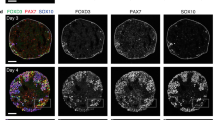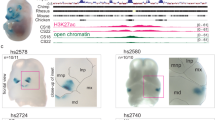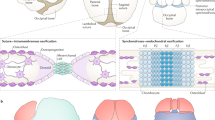Abstract
IN various experimental animals, clefting of the developing secondary palate can be induced by the administration of glucocorticoids to pregnant animals1–4. Various inbred strains of mice exhibit different degrees of susceptibility to glucocorticoid-induced cleft palate5–8. Specifically, A/J mice treated with glucocorticoids between days 11 and 14 of gestation (day of detection of vaginal plug designated day 0 of pregnancy) produce 100% of their offspring with cleft palate, whereas C57BL/6J (C57) mice similarly treated produce off spring with only 20–25% cleft palate. Although it has been demonstrated that glucocorticoids can elicit divergent physiological responses in various differentiated cell types through a class of specific cytoplasmic and nuclear receptor proteins9–11, the exact molecular mechanism(s) by which glucocorticoids function as teratogens as well as the aetiology of the strain-specific difference in the response to glucocorticoids are unknown. We present here evidence that mouse facial mesenchyme cells obtained either directly or in primary culture possess specific glucocorticoid-receptor proteins of high affinity and limited capacity for dexamethasone. Furthermore, we report that A/J facial mesenchyme cells possess approximately double the amount of receptor proteins than C57 mesenchyme cells.
This is a preview of subscription content, access via your institution
Access options
Subscribe to this journal
Receive 51 print issues and online access
$199.00 per year
only $3.90 per issue
Buy this article
- Purchase on Springer Link
- Instant access to full article PDF
Prices may be subject to local taxes which are calculated during checkout
Similar content being viewed by others
References
Baxter, H., and Fraser, F. C., McGill med. J., 19, 245–249 (1950).
Shah, R. M., and Travill, A. A., Teratology, 13, 71–84 (1976).
Fainstat, T. D., Endocrinology, 55, 502–508 (1954).
Hendrickx, A. G. et al., Fedn Proc., 34, 1661–1665 (1975).
Fraser, F. C., Kalter, H., Walker, B. E., and Fainstat, T. D., J. cell. comp. Physiol., 43, Suppl. 1, 237–259 (1954).
Kalter, H., Genetics, 39, 185–196 (1954).
Loevy, H., Anat. Rec., 145, 117–122 (1963).
Dostál, M., and Jelinek, R., Teratology, 8, 245–252 (1973).
Thompson, E. B., and Lippman, M. E., Metabolism, 23, 159–202 (1974).
Hechter, O., and Halkerston, I. D. K., A. Rev. Physiol., 27, 133–162 (1965).
Cake, M. H., and Litwack, G., in Biochemical Actions of Hormones (edit. by Litwack, G.), 317–390 (Academic, New York, 1975).
Baxter, J. D., Higgins, S. J., Rousseau, G. G., in Meth. Enzymol., 36 (edit. by O'Malley, B. W., and Hardman, J. G.), 240–248 (Academic, New York, 1975).
Sibley, C. H., and Tomkins, G. M., Cell, 2, 221–227 (1974).
Rousseau, G. G., Baxter, J. D., and Tomkins, G. M., J. molec. Biol., 67, 99–115 (1972).
Lowry, O. H., Rosebrough, N. J., Farr, A. L., and Randall, R. J., J. biol. Chem., 193, 265–275 (1951)
Scatchard, G., Ann. N. Y. Acad. Sci, 51, 660–672 (1949).
Baxter, J. D., Harris, A. W., Tomkins, G. M., and Cohn, M., Science, 171, 189–191 (1971).
Rosenau, W., Baxter, J. D., Rousseau, G. G., and Tomkins, G. M., Nature new Biol., 237, 20–24 (1972).
Hackney, J. F., Gross, S. R., Aronow, L., and Pratt, W. B., Molec. Pharmac., 6, 500–512 (1970).
O'Malley, B. W., and Schrader, W. J., Scient. Am. 234, 32–43 (1976).
Rousseau, G. G., Baxter, J. D., Higgins, S. J., and Tomkins, G. M., J. molec. Biol., 79, 539–554 (1973).
Croce, C. M., Koprowski, H., and Litwack, G., Nature, 249, 839–841 (1974).
Spain, K. M., Kisieleski, W., and Wood, N. K., J. dent. Res., 54, 1069–1077 (1975).
Rubmann, A. G., and Berliner, D. L., Endocrinology, 76, 916–927 (1965).
Cox, R. P., and MacLeod, G. M., J. gen. Physiol., 45, 439–485 (1962).
Fodge, D. W., and Rubin, H., Nature, 257, 804–806 (1975).
Pratt, W. B., and Aronow, L., J. biol. Chem., 244, 5244–5250 (1966).
Mott, W. J., Toto, P. D., and Hilgers, D. C., J. dent. Res., 48, 263–265 (1969).
Jelinek, R., and Dostál, M., Teratology, 11, 193–198 (1975).
Author information
Authors and Affiliations
Rights and permissions
About this article
Cite this article
SALOMON, D., PRATT, R. Glucocorticoid receptors in murine embryonic facial mesenchyme cells. Nature 264, 174–177 (1976). https://doi.org/10.1038/264174a0
Received:
Accepted:
Issue Date:
DOI: https://doi.org/10.1038/264174a0
This article is cited by
-
Influence of H-2-linked genes on glucocorticoid receptors in the fetal mouse palate
Immunogenetics (1981)
-
Genetic control of hydrocortisone-induced thymus atrophy
Immunogenetics (1979)
Comments
By submitting a comment you agree to abide by our Terms and Community Guidelines. If you find something abusive or that does not comply with our terms or guidelines please flag it as inappropriate.



